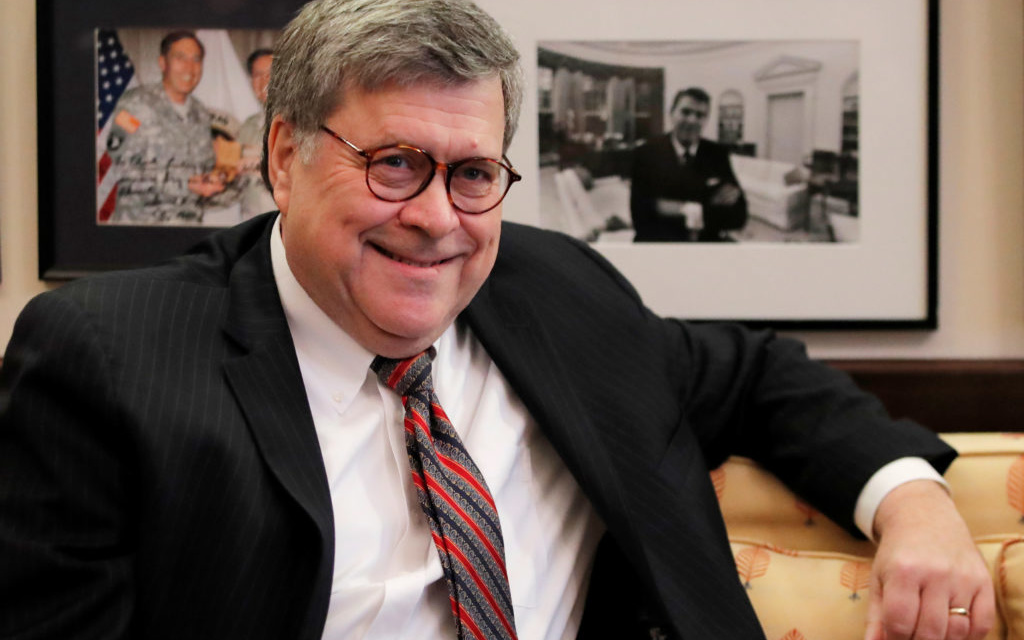William Barr, then Attorney General nominee, Capitol Hill, Washington, January 9, 2019 (Jim Young/AP)
Attorney General William Barr gives Donald Trump vital cover over Special Counsel Robert Mueller’s report on links between the Trump campaign and Russian officials in 2016.
In his four-page letter summarizing the report on Sunday, Barr — confirmed only last month in his post — wrote, “[T]he investigation did not establish that members of the Trump Campaign conspired or coordinated with the Russian government in its election interference activities.”
Barr said that Mueller “did not draw a conclusion – one way or the other – as to whether” Trump obstructed justice in his attempts to block the investigation since 2017: “While this report does not conclude that the President committed a crime, it also does not exonerate him.”
The Attorney General then intervened to try and put Trump beyond any legal jeopardy: “The evidence developed during the Special Counsel’s investigation is not sufficient to establish that the President committed an obstruction-of-justice offense.”
See also Snap Analysis of the Mueller Report and the Attorney General’s Letter
Framing “No Conspiracy”
Barr’s headline clearance of Trump collaboration with Russia rested on a narrow framing of the question and “conspiracy”.
In a footnote ignored in almost all news coverage, the Attorney General based his presentation on “coordination” as an “agreement — tacit or express — between the Trump Campaign and the Russian government on election interference”.
However, the publicly-available evidence on the Trump campaign’s links with Russian officials has not portrayed “coordination”. Instead, it has been concerned with whether Trump and his closest advisors knew of the Kremlin’s efforts in 2016 and made no effort to check — and perhaps encouraged — the interference, including the hacking of computers and dissemination of material to damage Democratic candidate Hillary Clinton.
Trump’s campaign staff met Russian-linked contacts throughout spring and summer 2016 to discuss the matter. The encounters included a Trump Tower meeting in June 2016 between three Kremlin-linked envoys and Trump’s top advisors — Donald Trump Jr.; son-in-law Jared Kushner; and campaign manager Paul Manafort.
In January, advisor Roger Stone was indicted over another dimension of the contacts: arrangements with WikiLeaks to disseminate anti-Clinton e-mails hacked by Russian military intelligence.
See also Russia Investigation Closes on Trump with Arrest of Roger Stone
Sweeping Away Obstruction of Justice
Barr was unable to portray a Mueller clearance of Trump on obstruction of justice, but he quickly moved to bury any further action.
The Attorney General used the rationale that, since the Special Counsel had not found Trump’s involvement in “an underlying crime related to Russian election interference”, Trump — whose actions have included the firing of FBI Director James Comey and threats to remove Deputy Attorney General Rod Rosenstein and Mueller — could not have made any attempt to obstruct the investigation of that possible crime:
The government would need to prove beyond a reasonable doubt that a person, acting with corrupt intent, engaged in obstructive conduct with a sufficient nexus to a pending or contemplated proceeding.
Will Report Be Released?
Attention now turns to whether Mueller’s report will be made available to sets its evidence and findings against Barr’s summary.
The Attorney General indicated that he will use other legal proceedings against Trump and his associates as the rationale to keep the report hidden for now. In a lengthy paragraph of legal terminology, he cited the need to restrict disclosure over any case before a grand jury and over “other ongoing matters, including those that the Special Counsel has referred to other offices” — the Mueller team’s handover of information to Federal and State prosecutors.
Paradoxically, then, the 12 cases in Federal and State courts against Trump, the Trump Organization, the Trump Foundation, and the Trump inaugural committee could protect Trump against any public release.
Trump Exaggerates, Attacks Mueller
Uncharacteristically silent since the submission of Mueller’s report to Barr on Friday, Trump quickly reacted to exaggerate and distort the Attorney General’s letter, falsely saying it had established “no obstruction”.
“It was a complete and total exoneration,” Trump told reporters in Florida before boarding Air Force One to return to the White House.
Despite that supposed exoneration, he maintained his attack on Mueller and US agencies:
It’s a shame that our country had to go through this. To be honest, it’s a shame that your president has had to go through this.
This was an illegal takedown that failed. Hopefully, someone’s going to be looking at the other side.
Democrats indicated that, while pursuing release of the report, they will continue hearings. Rep. Jerry Nadler, the chairman of the House Judiciary Committee, wrote on Twitter:
In light of the very concerning discrepancies and final decision making at the Justice Department following the Special Counsel report, where Mueller did not exonerate the President, we will be calling Attorney General Barr in to testify before @HouseJudiciary in the near future.
— (((Rep. Nadler))) (@RepJerryNadler) March 24, 2019
House Speaker Nancy Pelosi and Senate Minority Leader Charles Schumer said Barr’s letter “raises as many questions as it answers” and refers to articles, before he took office, where the Attorney General attacked the Mueller investgiation: “Given Mr. Barr’s public record of bias against the Special Counsel’s inquiry, he is not a neutral observer and is not in a position to make objective determinations about the report.”
They repeated their demand for the Mueller report to be made public: “The American people have a right to know.”


I wonder if the general discourse will take up and focus on this apparently important but subtle point about “coordination” as tacit agreement